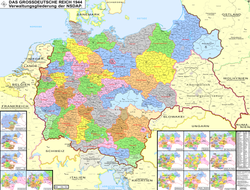Overview
The Gauliga Ostmark was introduced by the Nazi Sports Office in 1938, after Austria's annexation, to replace the previously existing national league (German:Nationalliga) in the occupied country. The former country of Austria was renamed Ostmark (English:Eastern March) and became part of Germany until 1945. The renaming of Austria to Ostmark was carried out to eradicate all recognition of the country's former independence from Germany. To take matters further, the FK Austria Wien was also renamed in April 1938, to SC Ostmark Wien. This step however was revoked two months later and the club remained one of the few, if not only, institutions to be permitted to carry the former country's name. [1]
Unlike the professional Austrian Nationalliga, the new Gauliga was supposed to be strictly an amateur league. [2]
The new league consisted of six clubs from the old Austrian first division, all based in Vienna and the champion of the second-tier Vienna league (German:Wiener Liga). Additionally, the three champions of the regional leagues of Niederdonau, Oberdonau and Styria were also admitted to the new Gauliga. As such, it was only the second time in the history of Austrian football for regional clubs to take part in the premier competition of the country. Previously, this level had only been open to clubs from Vienna but, in 1937, a national league had been formed with non-Vienna clubs in it for the first time. [3]
In its first season, the league had ten clubs, playing each other once at home and once away. The league winner qualified for the German championship while the bottom three teams were relegated. The league was reduced to eight teams for the 1939–40 season, with the bottom club being relegated.
In 1940–41, the Gauliga Ostmark returned to a strength of ten clubs. After the German occupation of Yugoslavia in April 1941, parts of what is now the country of Slovenia were added to the two southernmost Gaue in the Ostmark. Additionally, the league was renamed Gauliga Donau-Alpenland. However, no clubs from the annexed part of Yugoslavia did take part in the league.
The league was reduced to nine clubs during the 1941–42 season due to the withdrawal of Sturm Graz. The season after, it played with eleven teams. In 1943–44, it again played with nine teams only.
The imminent collapse of Nazi Germany in 1945 gravely affected the Gauligas and the league's last season 1944–45, played with ten teams, was not completed. After nine of eighteen rounds, the competition was halted on 11 March 1945. [4]
National success
The clubs from former Austria had considerable success on national German level, with Rapid Wien in 1941 becoming the only club from outside of the current borders of the Federal Republic of Germany to claim the German national title. Additionally, Admira in 1939 and First Vienna in 1942 both lost the national final to FC Schalke 04. Rapids win over Schalke in 1941, in front of 100,000 spectators in Berlin, is still considered one of the most remarkable German finals, as Schalke led 3–0 after 60 minutes to lose 3–4 after full-time. [5]
Das große Spiel (The big game), a movie about a fictitious German football team, Gloria 03, directed by Robert Stemmle and released in 1942 uses footage of the 1941 German championship final Rapid Wien versus FC Schalke 04. [6]
In the cup competition, Rapid again took out one title, in 1938 while First Vienna won the last competition before the end of Nazi Germany, winning in 1943.
Aftermath
At the end of the Second World War, Austria was reestablished as an independent country, occupied by the four allied powers. A national football competition was formed again in 1945, the Erste Liga (English:First League) later being renamed Staatsliga and, from 1974, Austrian Bundesliga, kicking off on 1 September 1945. [4] In the early post-war years, clubs from outside of Vienna were again barred from the top division and only in 1948 did the league become truly national, admitting regional clubs again. [8]
The occupied parts of Yugoslavia became part of the new Socialist Federal Republic of Yugoslavia and reverted to Slovenia.
This page is based on this
Wikipedia article Text is available under the
CC BY-SA 4.0 license; additional terms may apply.
Images, videos and audio are available under their respective licenses.
